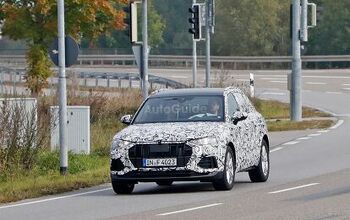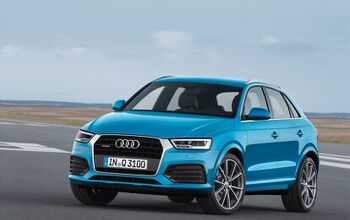The 2026 Audi Q3 Is Here

As Audi's most popular global SUV, the Q3 enters its third generation with fresh styling, a streamlined interior layout, and multiple powertrain options.
Key Points
- Audi has revealed the third-generation Q3 with a sharper design, revamped digital interior, and a choice of gasoline, diesel, and plug-in hybrid powertrains offering up to 268 hp.
- The redesigned crossover introduces a minimalist cockpit layout, larger infotainment displays, and eco-conscious materials, along with new features like a relocated gear selector and customizable ambient lighting.
- Set to launch in Europe this fall, the Q3 remains Audi’s entry-level SUV globally and adds expanded driver assistance tech and upgraded suspension options aimed at refining ride and handling.
The new exterior design delivers the latest in Audi’s evolving visual identity. The upper daytime running lights consist of 23 LED segments per side and can be configured in one of four selectable signatures, each with its own startup and shutdown animations. Positioned beneath them, the Q3 offers Digital Matrix LED headlights for the first time. Audi says each headlight houses over 25,000 individual LEDs.
Out back, the Q3 features an illuminated Audi badge, optional digital OLED taillights, and a new LED light bar spanning the tailgate.
2026 Audi Q3: All The Details
Pronounced wheel arches now accommodate tires up to 20 mm wider than before, with wheel sizes ranging from 17 inches for base models to optional 20-inch designs for upper levels. Aerodynamic improvements have reduced the drag coefficient to 0.30, and the available S line appearance package includes unique bumpers and selenite silver trim.
There are no fake exhaust tips on the newest Q3, a welcome departure from Audi's questionable habit of the past—the exhaust exits below the vehicle, with eventual SQ3 or RS Q3 variants likely to show their tips. In profile, the resemblance to the Q5 is pronounced, with the redrawn roofline and reshaped rear quarter windows working to create a more dynamic profile.
Inside, the Q3 doesn’t stray far from Audi’s newest cabin motif. The touchscreen-centric layout centers on a 12.8-inch MMI display and an 11.9-inch digital gauge cluster, both running Google’s Android Automotive OS. Touch-sensitive controls remain on the steering wheel, though physical switches survive for critical functions. Audi has moved the gear selector to a steering column-mounted stalk, freeing up space between the seats. That redesign accommodates larger cupholders, a cooled wireless charging pad, and USB-C ports. A new multifunction stalk on the left now handles lighting, wipers, and turn signals.
Audi has also added subtle lighting enhancements, including customizable ambient light strips with laser-perforated illuminated door panels and dash accents. A new AI-based assistant appears as an avatar on-screen and can control a variety of vehicle functions. A 12-speaker Sonos audio system is also available, along with newly added acoustic glazing for the front side windows.
The Impressum cloth seat fabric is made entirely from recycled polyester, and the floor mats use Econyl—recycled nylon reclaimed from fishing nets and carpet waste. Rear seat occupants benefit from a sliding bench with adjustable backrests. Cargo capacity stands at 17.2 cubic feet behind the second row and expands to 48.9 cubic feet with it folded.
Powertrain options will vary depending on market. The base engine is a 1.5-liter turbocharged four-cylinder with cylinder deactivation and mild-hybrid assistance, producing 148 horsepower and 184 lb-ft of torque. Paired with a seven-speed dual-clutch automatic, it drives the front wheels.
A 2.0-liter gasoline version brings 261 hp and standard Quattro all-wheel drive. Diesel options include a 2.0 TDI with 148 hp and front-wheel drive, also matched to the dual-clutch gearbox. There’s no diesel and AWD combination at launch.
More complex is the plug-in hybrid, which combines the 1.5-liter gas engine with an electric motor to deliver 268 hp and 295 lb-ft. A 19.7-kWh battery provides up to 75 miles of electric range on the WLTP cycle, with 50-kW DC charging capable of restoring the battery from 10 to 80 percent in under 30 minutes. Unlike its combustion counterparts, the PHEV uses a six-speed automatic transmission.
The Q3 now supports “trained parking” functionality, allowing owners to record and automate specific maneuvers. In more critical scenarios, the updated emergency assist system can intervene and control the vehicle if the driver becomes unresponsive.
The 2026 Audi Q3 will go on sale in Germany in October, starting at €44,600. A U.S. launch is expected to follow, though specifications and pricing for North America will be announced at a later date. With the Q2 discontinued, the Q3 will serve as Audi’s entry-level crossover offering globally, with derivatives like the Q3 Sportback, SQ3, and potentially an RS Q3 likely to follow.
Become an AutoGuide insider. Get the latest from the automotive world first by subscribing to our newsletter here.

An experienced automotive storyteller and accomplished photographer known for engaging and insightful content. Michael also brings a wealth of technical knowledge—he was part of the Ford GT program at Multimatic, oversaw a fleet of Audi TCR race cars, ziptied Lamborghini Super Trofeo cars back together, been over the wall during the Rolex 24, and worked in the intense world of IndyCar.
More by Michael Accardi





































Comments
Join the conversation